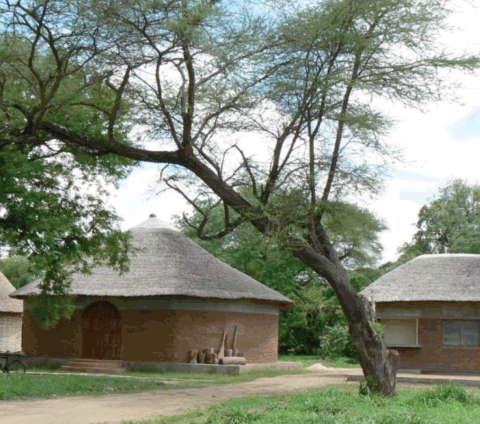

now known as Old Lengwe, primarily to protect the Nyala antelope. Lengwe National Park contains the northern most indigenous population of Nyala antelope in the world.
Old Lengwe was extended to the west to a total area of almost 900 sq kms in 1975. The extended area borders the Mwanza River and Mozambique. This extended area is a vast water catchment basin. The late President of Malawi, Dr. Hastings Kamuzu Banda, saw the danger in leaving this area unprotected, as it collects millions of litres of water during the wet season from the surrounding mountains. If left to deforestation it would have resulted in even worse flooding in the Lower Shire Valley than is being experienced today. Access to Lengwe is off the M8 about 20 kms south of Chikwawa. From this point, the distance to the park’s main gate is 9 kms on an earth-surfaced road. The first 7.5kms is well maintained as it cuts through large cane fields, belonging to Illovo Sugar
Estate. At the end of the cane fields you turn left, signposted Lengwe National Park, Nyala Lodge and Tisunge! Lower Shire Heritage Centre; on your way to the main gate you will also pass the residence of The Paramount Chief Lundu. Preservation of Natural and Cultural Heritage in Lengwe At the main gate you will find Tisunge! Lower Shire
Heritage Centre. Although Tisunge! Lower Shire Heritage Centre is still undergoing construction, several main buildings have been completed; like the exhibition building,
meeting area, curio shop, weaving area, library, two offices and an ablution block. Tisunge! has also initiated various projects, such as the reintroduction of traditional weaving and spinning, tree planting and the curio shop is in operation which sells the
traditionally woven cloth and other crafts all made in the Lower Shire Valley. Tisunge! is managed by the Lower Shire Heritage Trust, in which the Department of National Parks and Wildlife, the Department of Antiquities, Mlambe Foundation, Paramount Chief Lundu, TA Chapananga, African Parks Foundation and Jambo Africa Ltd (Nyala Lodge) are partners. Tisunge!’s primary objective is the preservation of cultural and natural heritage. The Trust and the centre are very committed and local artisans; members of the surrounding communities and enthusiastic volunteers are working closely together in aiding the surrounding communities of Lengwe National Park in income generating activities. It is intended that Tisunge! will become self sustainable through income generating projects like the setting up of an electrical maize mill for the communities, to attain that sustainability. However, all donations are very welcome. For further information on Tisunge! opportunities for volunteering and donations, please
visit: www.mlambefoundation.org
The beauty and uniqueness of Lengwe National Park
Lengwe has a unique biodiversity and forms an island of unspoilt natural habitat, isolated in a sea of human habitation. Its combination of trails, tracks and hides overlooking water holes during the dry months provide excellent opportunities for game viewing and photography. The road network only covers approximately 80 sq kms within Old Lengwe
but there are plans to increase the road network into the extension area. For now, if one wants to visit the western side of the park, one has to travel from the Lengwe turn-off to Tomali and then take a road to Kanzimbi. This road takes you all along the south western boundary of the park. Here, you are only a stone’s throw from Majete. This part of Lengwe is absolutely beautiful. Similar to Mwabvi, it has huge sandstone and granite formations covered by dense forests. Game is available, but not as abundant as in Old Lengwe, unfortunately, as due to the lack of road networks and limited government funding, the extension area has been less protected against poachers. Currently, there are new scout camps being constructed in the extension area and
Tisunge!, in cooperation with the Kanzimbi Community Based Organisation, has requested funding for the building of community bush camps. If the funding comes through, Tisunge! and Kanzimbi CBO, in cooperation with Nyala Lodge will start organising 3 to 4 day trips including a two day bush walk through the park and a cultural tour through the surrounding villages. So, with time, this extension area will hopefully also be suitably protected. The park hosts numerous animals, including buffalo, hyena, kudu, warthog, bush pig, porcupine, pangolin, aardvark, caracal, civet, cerval, nyala, impala, leopard and many other smaller animals including five primates. Lengwe is famous for over 350 species of birds, a true ornithological paradise! Wildlife and nature
enthusiasts will enjoy the diversity of animals, flora and fauna that Lengwe has to offer.
An important Historical Site The area of Lengwe was not always a designated national park and the cultural history of the park is amazing. BoAn important Historical Siteh archaeological and historical sites have been found in the park. The most recent sites are the remains of villages that were abandoned in the park at the time of its creation (1970s). Lengwe has some impressive baobab trees and at the base of some of these majestic baobabs, sacrificial pots dating from the 19th century can be found. In the extension area of Lengwe, archaeological surveys have been conducted of an iron smelting site and of an 18th century site. The oldest remains in the park thus far are found at Mbwawala in the form of an early Iron Age site dating from the 3-8th century AD. Around Nyala Lodge (see below) some 14-16th century pot sherds associated with the Lundu settlement
have been found. Just outside the park, behind the Paramount Chief Lundu’s residence, a sacred grove including a shrine was found at the place where, according to oral history, the first settlement of King Lundu was located. At this location archaeological excavation, however, revealed 19th century material. On the other side of the current residence of Paramount Chief Lundu, though, evidence has been found of the Lundu
King’s possible first settlement dating as far back as the 11th century. At the Lundu shrine at Chifhunda Lundu, remains of rain sacrifices in the form of beer sacrifices, white and blue beads and even a human canine have been found. These sacrifices date from
the 19th century. Between the villages of Mphampa and Tomali, on the border of Lengwe, an early Iron Age settlement and a 14-16th century site were found. The Tomali gravel pits at the Chomwa stream contain Middle Stone Age deposits of 20,000-100,000 year-old stone tools!
Accommodation
Approximately a kilometre from the main gate inside the park you will find Nyala Lodge; the only accommodation available within the park. The lodge offers comfortable en-suite chalets – two with air conditioning and fans, the other six with fans only – all with hot running water and mosquito nets. Alfresco dining is the norm, with delicious meals available to resident guests as well as to day visitors. The lodge also offers a well stocked bar (“The Thicket”). Drinks can be taken on the deck, which overlooks a waterhole and provides great game viewing while relaxing, and by the small pool where one can have a refreshing dip on the warmer days. The Lodge also offers a camp site with ablutions (ladies & gents) with hot running water. As well as offering tents for hire, there are now two very cosy ‘A’ frames on raised pillars, with a thatched roof, beds, mosquito nets, lights, electrical power point and fan at the campsite for those who wish to camp in comfort. For more info contact: jamboafrica@africa-online.net

©2001-2015 The Eye Malawi. All Rights Reserved.